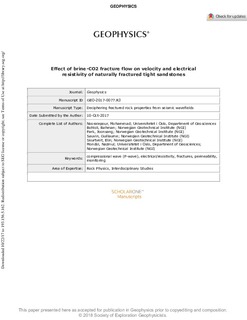| dc.description.abstract | Fracture networks inside geological CO2 storage reservoirs can serve as primary fluid flow conduit, particularly in low-permeability formations. While some experiments focused on the geophysical properties of brine- and CO2-saturated rocks during matrix flow, geophysical monitoring of fracture flow when CO2 displaces brine inside the fracture seems to be overlooked. We have conducted laboratory geophysical monitoring of fluid flow in a naturally fractured tight sandstone during brine and liquid CO2 injection. For the experiment, the low-porosity, low-permeability naturally fractured core sample from the Triassic De Geerdalen Formation was acquired from the Longyearbyen CO2 storage pilot at Svalbard, Norway. Stress-dependence, hysteresis and the influence of fluid-rock interactions on fracture permeability were investigated. The results suggest that in addition to stress level and pore pressure, mobility and fluid type can affect fracture permeability during loading and unloading cycles. Moreover, the fluid-rock interaction may impact volumetric strain and consequently fracture permeability through swelling and dry out during water and CO2 injection, respectively. Acoustic velocity and electrical resistivity were measured continuously in the axial direction and three radial levels. Geophysical monitoring of fracture flow revealed that the axial P-wave velocity and axial electrical resistivity are more sensitive to saturation change than the axial S-wave, radial P-wave, and radial resistivity measurements when CO2 was displacing brine, and the matrix flow was negligible. The marginal decreases of acoustic velocity (maximum 1.6% for axial Vp) compared to 11% increase in axial electrical resistivity suggest that in the case of dominant fracture flow within the fractured tight reservoirs, the use of electrical resistivity methods have a clear advantage compared to seismic methods to monitor CO2 plume. The knowledge learned from such experiments can be useful for monitoring geological CO2 storage where the primary fluid flow conduit is fracture network. | |
